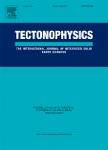版权所有:内蒙古大学图书馆 技术提供:维普资讯• 智图
内蒙古自治区呼和浩特市赛罕区大学西街235号 邮编: 010021

作者机构:The Hans Ramberg Tectonic Laboratory Department of Mineralogy and Petrology Institute of Geology Uppsala University Box 555 S-751 22 UppsalaSweden
出 版 物:《TECTONOPHYSICS》 (地质构造物理学)
年 卷 期:1988年第148卷第3-4期
页 面:211-219页
核心收录:
学科分类:0709[理学-地质学] 081803[工学-地质工程] 07[理学] 08[工学] 0708[理学-地球物理学] 0818[工学-地质资源与地质工程]
摘 要:The Messinian Salinity Crisis (MSC) was a catastrophic event which led to the deposition of 10 6 km 3 of evaporite in the Mediterranean between 6.5 and 5 Ma B.P. Stratigraphic investigations have previously suggested that the progressive increase of salinity in the Mediterranean leading to the MSC may have been caused by tectonic narrowing and closure of seaways between the Mediterranean and the Atlantic. Detailed reconstruction of the tectonic history of the Arc of Gibraltar and adjacent Alboran Basin independently suggests: 1. (1) that the early Miocene Guadalquivir and Alboran seaways closed and narrowed, respectively, near the end of the Tortonian, 7 Ma B.P., and 2. (2) that the tectonic Arc of Gibraltar progressively emerged above the sea level during the Messinian (7-5 Ma B.P.) which caused, together with a eustatic glacial lowering of the sea level, the isolation and subsequent dessication of the Mediterranean. This is in agreement with a two-stage history of the MSC previously postulated on the basis of stratigraphical observations: 1. (1) deep-basin/deep-water and 2. (2) deep-basin/shallow-water salt deposition. The closure of the seaways between the Mediterranean and the Atlantic and the associated drop in world-wide oceanic surface salinity may even have caused the Kapitean-Optian glacial event about 5.5 Ma B.P.